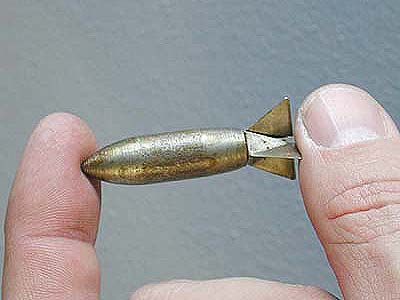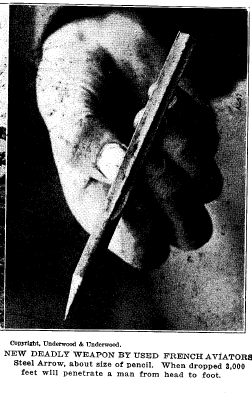During Nam, the Rand Corp. persuaded the USAF to try dropping “bomblets” (a term later applied to cluster munitions) from B52s. These were also called “Lazy Dogs”. These were solid steel gizmos shaped exactly like WW II general-purpose 500 lb models, blunt body, tail fins, and all. They were about 2" long, weighed a few ounces and achieved a terminal velocity somewhat slower than a .45 ACP. The idea was to leave Uncle Ho wondering fearfully why people were dropping dead when there was just a whisper of engines in the sky far above. Didn’t work worth a goddamn.
Half of the problem is no doubt once dropped from a B52's altitude they'd be so dispersed that there was only a randon chance of being hit.

This article indicates that Lazy Dogs were used from more practical platforms than B-52s.
Lazy Dogs can still be found for sale on ebay. (right)
The models used in WW1 seem far better designed.
A typical example would be 3-5" in length and about 8 mm diameter.
A velocity of 150 m/sec is quoted if dropped from 2000 m, and 100 m/sec if dropped from 1000 m.
The book “Winds of Destruction: the Autobiography of a Rhodesian Combat Pilot” By Peter J. H. Petter-Bowyer on page 301-2 describes experiments with darts made from 6" nails.
Two cannisters, each of 4,500 darts released at 450 kts resulted in 9,000 darts landing in a 900 metre long by 70 metre wide area. A projectile density in one second equivalent to the fire of 450 .303 Browning machine guns.
Flechette rockets such as the M255 2.75" FFAR containing 2,500 28 gr (1.8 gm) or 1,180 60 gr (3.9 gm) flechettes will be familiar to many readers.
A not so well known variation on this idea were the 68mm SNEB and 100mm rockets produced by the French company Thomson-Brandt (later Thomson-CSF).
These contained heavier darts or “fleché” designed to destroy lightly armoured and soft‑skinned vehicles.
Types marketed included:
68mm SNEB rocketsMulti-Dart ABL 261-8: Each of the 8 dart sub-munitions is 13.5mm dart (0.53") in diameter and 270 mm (10.63") long with a weight of 190 g (6.7 oz). Range 1,500-2,200 m. Dart velocity at 1,800 m is 500 m/s. Penetration up to 15 mm (0.59") of armour.
Multi-Dart 261-36 AMV: Each of the 36 darts is 9mm (0.35") in diameter and 132 mm (5.2") long with a mass of 35 g (1.23 oz). Range 1,500-2,200 m. Dart velocity at 1,800 m is 400 m/s. Penetration up to 8 mm (0.315") of armour.
Multi-Dart 100mm AB 24: Uses 6 darts each 24mm (0.94") in diameter and 548 mm (21.57") long, 1.65 kg (58.2 oz) weight. Capable of penetrating up to 80 mm (3.15") of armour.
Multi-Dart 100mm ABL (Light Anti-Armor): Uses 36 darts each 13.5mm (0.53") in diameter and 270 mm (10.63") long, 190 g (6.7 oz) weight. Capable of penetrating up to 15 mm (0.59") of armour.
Multi-Dart 100mm AMV (Anti-moving vehicle): Uses 192 Darts each 9mm (0.35") in diameter and 132 mm (5.2") long, 35 g (1.23 oz) weight. Capable of penetrating up to 8 mm (0.315") of armour.
A 22‑round pod of 68mm AMV rockets each with 36 darts would in 4.5 seconds blanket an area 1,000 m x 70 m with 792 darts. Maximum speed of a 68mm AMV rocket is 760 m/s (2,493 ft/s). No reason why a properly designed dart would not remain lethal after punching through the average roof.
The Canadian CRV7 rocket is an upgraded iteration of the American Hydra 70 2.75" FFAR.
WDU-5002/B FAT warhead, “Flechette Anti-Tank”, containing five tungsten‑reinforced steel flechettes that can penetrate a T-72's side and top armour at a range of 3,000 metres.
WDU-500X/B GPF, “General Purpose Flechette” which releases 80 tungsten flechettes (18 g/280 gr) that can penetrate 1.5 inches (38 mm) of roll-hardened armour (RHA).
On the original subject, which was full‑sized “solid” bombs, the only drawback I can see is that these would need to be dropped from altitude so would be the weapon of high‑flying bombers or UAVs rather than the tree‑top hoppers.
The Germans made some use of the Röchling anticoncrete round fired from a battlefield 210mm gun.
Tests on captured French and Belgium forts proved it could go through earth cover, concrete burster plates, concrete roof (often 10 metres thick), the room below and through the floor before detonation.
It may be that our solid bombs are too good at penetration and will need to be designed so they break up on impact to transfer some of their energy.
Payload: 3,750 non-explosive steel and tungsten penetrator rods of various sizes:
- 350 14 inch tungsten rods
- 1,000 7 inch tungsten rods
- 2,400 2 inch steel rods
By the Author of the Scrapboard : | |
|---|---|
 | Attack, Avoid, Survive: Essential Principles of Self Defence Available in Handy A5 and US Trade Formats. |
 | |
 | Crash Combat Fourth Edition Epub edition Fourth Edition. |
 | |
 | |
